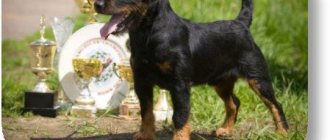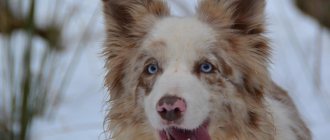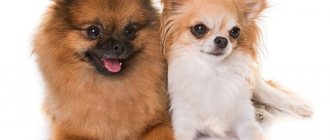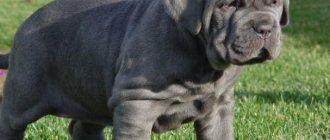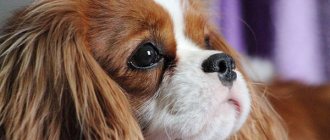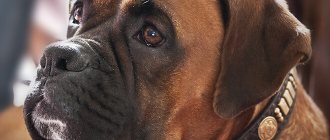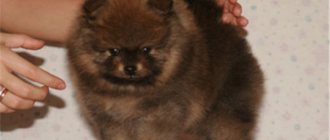History of the breed
How and when this breed appeared is currently quite difficult to say. However, experts claim that their ancestors were dogs domesticated by tribes of cattle breeders living in Tibet a couple of millennia BC. Subsequently, cattle breeders kept only the strongest of the tamed pets - this is how the breed of Tibetan dogs arose through natural selection. Subsequently, as a result of crossing these strong and powerful dogs with dog breeds that came to Tibet from outside, two new breeds were born: Asian Shepherds and Tibetan Great Danes (the ancestors of the group of modern Great Danes).
These dogs were taken with them on hikes and travels; as a result, Tibetan Great Danes appeared in other Asian countries, in particular in China, India, and Mesopotamia. These dogs developed the following qualities: strength, aggressiveness, and their powerful jaws could bite through the weapons of enemies (we are talking about the 1st-2nd millennium BC). Then these dogs came to Europe - first to Greece and the Roman Empire, and then to other countries.
By the tenth century AD, most of the descendants of the Tibetan Great Danes were in Germany. The Code of Forest Hunting Laws specifically described the descendants of these dogs (7 types of Great Danes). These domestic animals were used to hunt wild boars and bears, which already speaks of the strength of these dogs. After another 5 centuries, the direct ancestors of modern Great Danes appeared in Germany. Some experts believe that these individuals were obtained by crossing Molossians with English hunting breeds. As a result, this breed was called by different names:
- Great Danes;
- Great Danes;
- Old German Mastiffs;
- Bullenbeisers.
On the territory of Denmark and the German regions adjacent to it, the Great Dane was mainly bred, which was taken to breed purebred Great Danes, which exist today.
It was the Great Dane that became the standard of a fighting and guard dog, which was used in hunting to bait large wild animals. But later in Denmark the breeding of this breed practically ceased, so most of the Great Danes were concentrated in Germany, where by the middle of the nineteenth year, breeders began improving this breed by crossing Great Danes with other Great Danes. This subspecies is called the Ulm Great Dane. In northern Germany they also bred mastiff dogs.
Currently, there are several subspecies of the Great Dane breed, which, in addition to common features of appearance and character, also have some differences, which will be discussed in more detail in the descriptions of these varieties.
Description of the breed, characteristics
Among all large dogs, the Great Dane is one of the largest and most massive. And most likely, it was a representative of this breed that was described by Arthur Conan Doyle in his story “The Hound of the Baskervilles.”
The height of this pet at the withers can reach 0.8-0.9 m, but taller specimens are also found. The weight of an adult male can be up to 89-92 kg. The shape of the elongated muzzle depends on the subtype, the nose is quite wide, the nostrils are large. The shape of the eyes can be different, but most often it is almond. Tail length is slightly longer than average. Representatives of this breed are smooth-haired, which makes it easier for owners to care for their huge pets.
The body composition directly depends on the type of breed.
If the ancestors of these pets were distinguished by viciousness and aggressiveness, then modern Great Danes have practically lost these qualities - they have become calm and self-confident, they are distinguished by friendliness, sociability and devotion to their owner. However, with a lack of training and education, Great Danes can be stubborn and do not always control their behavior. It is simply impossible to do without long sessions with dog handlers when training puppies of this breed.
The Great Dane is a dog that will have to be spent a lot of time training and taking him for walks. You shouldn’t have such a huge pet in a small apartment, because it needs a lot of free space.
How to properly care
Dogo Argentinos do not require grooming. To maintain your pet's attractive appearance and health, you just need to follow simple hygiene rules.
Wool and bathing
The coat should be brushed 2-3 times a week with a soft brush with natural bristles, and during shedding, use a furminator..
If your pet lives in an apartment, then after every walk, especially in rainy weather, you need to wash its paws and belly.
Dogo Argentinos should be fully bathed no more than once a quarter, using a hypoallergenic shampoo appropriate for their coat type. Washing more frequently can cause loss of the fat layer needed to protect the top layers of skin in winter.
Ears
Twice a week you need to wipe your pet's ears with a cotton pad soaked in a special lotion to remove excess wax and dirt.
Claws
With regular active walks, the claws wear down on their own . If this does not happen, as they grow, they need to be shortened with a guillotine nail cutter.
Eyes
No additional eye care is required; they should be moderately moist . In case of severe souring, they need to be washed with warm boiled water; if this does not help, contact a veterinarian.
Teeth
To prevent the formation of plaque and tartar, once a week you need to brush your pet’s teeth with a special brush and toothpaste or tooth powder.
Breed standard
The main standard of the Great Dane breed implies the following characteristics of dogs:
- elongated body shape, proportionally folded;
- elongated muzzle with powerful jaws, high-set triangular ears;
- correctly placed strong limbs;
- tail – medium size and thickness;
- the coat is smooth, colors can be different - from marble to black;
- eyes are almond-shaped.
But different subtypes of this breed may have different standards.
Color variations
Dogo Argentino coats can only be white..
According to the breed standard, one or more small patches of black around the eyes are allowed, but they should not exceed 10% of the head area. A large number of spots is considered a breed defect.
The judges at the show will give preference to the whitest representative of the breed.
Advantages and disadvantages
The main advantages of this breed include:
- high intelligence;
- perfectly developed memory;
- smooth short coat that is easy to care for;
- can be a good guard or watchman.
These pets have practically no disadvantages. It may be noted that some individuals may have problems with the gastrointestinal tract - for example, volvulus. Also, these dogs have a short lifespan - about 8 years.
Varieties
There are several varieties of Great Danes, which differ quite greatly in appearance, so the main subtypes should be described in more detail.
German
Representatives of this subtype are among the largest dogs in the world. These pets can reach a height at the withers of up to 92 cm (males), and females - up to 83 cm. These natives from Germany weigh up to 89 kg - boys, girls are a little lighter - about 60 kg.
When this breed was bred, its purpose was to bait large wild animals (bears, wild boars). Currently, they are used as excellent companions, guard dogs or watchdogs.
The standard for this subtype is as follows:
- head – elongated, narrow, proportional to the length of the body;
- neck – larger than average size with well-developed muscles;
- rectangular muzzle with a wide nose and oval eyes;
- high-set ears of medium length;
- The body shape is square, in girls it can be elongated. The short back smoothly transitions into a slightly curved lower back, the wide chest descends almost to the knee joints. The abdomen is usually tucked in;
- the front and hind legs are strong, correctly placed, the paws are dense, rounded;
- smooth, dense wool can have the following colors: black, blue, brindle, fawn, merle.
Bordeaux
Dogues de Bordeaux were bred by French breeders. These huge dogs can reach a height of 68 cm at the withers, and their weight can range from 52 to 90 kg.
The skin of these dogs is wrinkled, forming many folds on the face and body. Body – with well-developed muscles and a wide chest. The large head with a wide frontal part and a blunt muzzle is attached to the body by a small neck. Legs are short and strong.
These dogs are smooth-haired, the color can only be red (of different shades). According to the standard, there may be a darker mask on the face, and one large white spot on the chest.
Argentinian
This dog is built like an athlete, like a Great Dane, and can be a watchman, hunter or guard. The height of males does not exceed 66-67 cm, females - up to 64 cm. Their weight does not exceed 43-44 kg.
But the appearance of the Dogo Argentino is quite intimidating due to the powerful jaws and general expression of the muzzle.
His body is strong, with well-developed muscles, his back is wide, his lumbar region is powerful and his chest is voluminous. The head is shorter than that of Great Danes, with wide nostrils, thick lips, ears set high, and almond-shaped eyes. Argentines are smooth-haired, with snow-white soft fur. The neck is powerful, with good muscles. The straight, powerful limbs end in rounded paws.
The most popular colors
The Great Dane is characterized by shiny, smooth fur and dense skin with bright pigment. Based on color, the breed is conventionally divided into three groups: fawn, harlequin and blue.
Pale yellow
It is usually a uniform color ranging from pale to deep gold. According to standards, a black mask is preferable. Additional spots in this color are not welcome, although they are possible.
Marble
This group includes two colors - merle and brindle. Brindle corresponds to fawn in all respects (shades and spots), but the presence of even black stripes in the direction of the ribs is mandatory.
The merle color is characterized by a general white background, on which ragged black spots are unevenly located. The general background in this case can be gray, but this color is less preferable.
Blue
There are also two options here: directly blue and black.
If we talk about black, then it is necessary to note its depth and richness. In the black color, the presence of white spots in different combinations is allowed - marked, spots, etc. The blue color is characterized by a steel tint, white spots are also allowed, only fawn and black shades on the coat are rejected.
Maintenance, care
The maintenance of these large pets begins with preparing a place for it, which is not recommended to be changed in the future. Since the Great Dane puppy will grow into a huge dog in the future, he needs a lot of space in the apartment, as well as a lot of free time from the owner for joint activities with the pet. Therefore, if the apartment is small, or all family members are too busy, then it is better not to purchase a Dog.
It is also not recommended to get this particular dog if the novice dog breeder has not previously had experience raising these particular pets. After all, raising and training these huge and sometimes very stubborn dogs requires from the dog breeder not only time, but also skill, as well as strength, patience and a certain character, so that the dog can feel who is in charge in the house.
These pets (due to their large size) require long daily walks. And if the puppy should not be forced against his will to take long walks, then older pets themselves are willing to go for walks with the owner. Moreover, when walking different subtypes of Dogs, it is better to alternate between just walking and jogging. The best place for walking is on hard ground, where the dog can run calmly without knocking its paws.
Great Dane subspecies with long legs can often have joint problems, so you should be careful about the appearance of even mild lameness. Also, such dogs are prone to colds, so there should be no drafts in the place where your pet will rest, and you should also provide him with soft bedding.
You need to bathe your Great Dane when it gets dirty, and you need to brush it daily. It is better to use a special massage brush for this.
Feeding
It is better to feed such dogs homemade food. But it should be remembered that in the spring and summer the diet should contain less food rich in proteins and carbohydrates, but in the fall and winter the amount of such food is increased. As the puppies grow, the amount of food increases in proportion to the dogs' growth.
The puppy at home continues to be fed the same food that he received from the breeder, but gradually you can accustom him to an adult diet. Such large breeds need meat in sufficient quantities, but it is better not to feed chicken.
Upbringing
It is better to start raising such proud and slightly stubborn pets from the first day the puppy appears in the house. The main thing is that the puppy gets used to the owner and trusts him completely.
Important! These dogs are highly intelligent and quickly remember commands. Training puppies should begin with walking on a leash - these dogs do not like this procedure, so they should be taught without shouting, rewarding them for the slightest achievement.
Gradual training of a puppy in the rules of behavior in the house and on walks can begin from childhood, but serious training begins no earlier than the dog is six months old. It is better to take the Dog to an experienced instructor at the first stage of training - he will teach the dog basic commands and tell the owner how to practice them correctly at home or on a walk.
Parenting mistakes
Obvious mistakes in education include:
- irregular exercises with the dog;
- intemperance of the owner, practicing commands in a raised voice, frequent assault when the pet disobeys;
- training this large pet in crowded places, if the dog is not yet sufficiently trained.
Health
All representatives of the breed, including the black Great Dane, are characterized by poor health. It’s worth starting with the fact that their skeleton is quite weak. And the metabolism is not very good - it is slow. Here are the ailments your pet may encounter:
- The real tragedy for the Apollos is intestinal volvulus. Half of the dogs die from this disease. Among the breeds that are prone to the disease, Great Danes come first. Volvulus is the rotation of internal organs around their axis. Without urgent veterinary intervention, the animal dies within a few hours. The need for surgery in this situation is extremely high.
- In second place is a disease such as hip dysplasia. And it’s not surprising, with such height and weight this is quite understandable.
- The next disease that these dogs are prone to is hypothyroidism. This thyroid disease occurs quite often in Great Danes.
- Cataract and glaucoma. Giants did not escape eye problems. This is especially evident in the last years of their lives.
- Entropy or entropion of the eyelids. Along with volvulus, this is a scourge for representatives of the proud breed.
- Osteosarcoma. One of the most popular malignant tumors. Up to 85% of dogs have it. Why this happens has not yet been established. Doctors are inclined to believe that osteosarcoma occurs mainly due to some kind of injury.
- Demodecosis. This is a parasitic disease that is the most difficult to treat.
- Aortic stenosis. It creates significant obstacles to the outflow of blood from the left ventricle to the aorta. Great Danes, due to their size, are significantly prone to this disease.
- Cardiomyopathy. And again the heart. And again a disappointing forecast for the Great Danes. Prone, very inclined.
Puppies
Before purchasing a Great Dane puppy, you should be aware that this is a dog that will grow very large and will require special care (in particular, you will need to walk it for a long time and train it regularly). If the future dog breeder does not have such an opportunity, it is better to choose puppies of simpler breeds for purchase.
Choosing a puppy
Young animals should be purchased at least 3 months old. Puppies at this age have already formed a strong skeleton, well-developed muscles, and the future pet itself is quite well-fed and active. Limbs – correctly placed, long enough.
Price
The price for such dogs ranges from 20 to 50 thousand rubles. This price range depends on whether the puppy has a pedigree, vaccination data and other necessary information. And the price for puppies from elite champion parents will be the highest. And, as a rule, sellers offer to use such puppies in the future for participation in exhibitions and further breeding.
Nutrition
The diet, in general, is not much different from that of other large breeds. The main requirement for nutrition is balance. Dry food is well suited for animals; there are special mixtures specifically for Great Danes. It is beneficial for the body to supplement the diet with natural products, but not from the master’s table, but only from the list of permitted ones:
Black Great Dane
- Dairy products.
- Raw chicken, beef, turkey.
- Raw fish – preferably sea fish.
- Eggs – raw, no more than 2 eggs per week.
- Porridge.
There is also a list of products that are contraindicated for Great Danes. They are poorly absorbed by the digestive system and may be one of the reasons for the deterioration of a dog’s health:
- Floury.
- Sweets.
- Smoked meats.
- Bean porridge.
- Spicy food.
Do not forget that a dog is a predator by nature. The abundance of food of plant origin is harmful to her. Although vegetables and fruits are not prohibited for dogs, they are accepted willingly and should not be abused.
Great Dane puppies
The volume of food eaten can be determined based on the weight of the animal. Up to 5% of its own weight is enough per day for an adult. The feeding frequency for dogs of all breeds is the same - twice a day.
Owner reviews
According to reviews from owners, Great Danes are dogs that will be devoted pets who love their owner and his family members. Proud and calm representatives of this breed, with proper training, will be calm in any situation, obeying only the orders of their owner.
Although representatives of this breed seem stern and angry, according to those who keep dogs of this breed, in fact, there is practically no manifestation of aggression in Great Danes, they get along well with other pets, love children and will never attack other dogs. walk.
Great Dane character
This amazing animal is harmonious in everything. His aristocratic appearance is not at all deceptive, so is his character. This is an incredibly kind, peace-loving dog, often thoughtful, slow, but at the same time mischievous and cheerful. Its size can confuse a stranger, which will not be amiss in certain circumstances. Yes, he can protect, and this is justified. Such a dog will never offend its own, except perhaps accidentally by hitting it with its powerful tail. How will he behave with strangers? The answer is simple: the way the owner will behave with them. That is, he is peaceful with friends and wary of enemies.
We advise you to read: Pomchi Dog Breed
Another feature: patient, devoted, courageous, self-confident, cheerful and sociable, he does not like loneliness.
The dog strongly senses the mood of the one who is nearby, he is always on the same wavelength with his owner.
Two unique features:
- slow;
- has a good memory;
